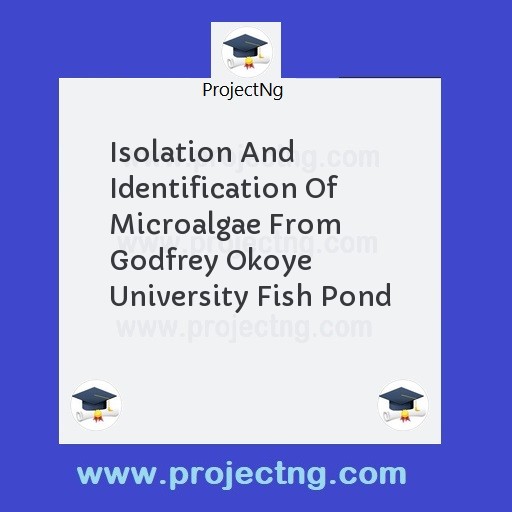Isolation And Identification Of Microalgae From Godfrey Okoye University Fish Pond
Microbiology Project Topics
Get the Complete Project Materials Now! »
ABSTRACT
Chlorella vulgaris is an edible microalgae and a highly notorious potential feed resource for many agriculturally important animal species. Chlorella vulgaris intake has also been linked to improvements in animal health and welfare. Its influence over animal development stems from its nutritive and protein-rich composition, thus leading to an increased commercial production to meet consumer demand. The aim of this work is to isolate and identify microalgae used in poultry farming and objectives of this research work is to determine the growth condition of microalgae and harvest microalgae used in poultry farming. Centrifugation of the sample to concentration the algal cells and plating using pour plate method was done. One percent agar-agar BG-11 medium was used for the algae isolation. Antibiotic added to avoid bacterial growth. Microscopic identification of the isolates based on cell morphology and colonial characteristics was carried out. The isolate was cultivated in a sterile BG-11 medium in presence of light and carbon dioxide and BG-11 medium as source of nutrient. Harvesting of chlorella vulgaris involves filtration, centrifugation and drying using hot oven at appropriate temperature. This study was able to isolate and identify the microalgae of interest, which can later be used in poultry farming in future study
TABLE OF CONTENT
Title page----------------------------------------------------------------------------------------------i
Approval page ----------------------------------------------------------------------------------------ii
Dedication --------------------------------------------------------------------------------------------iii
Acknowledgement ----------------------------------------------------------------------------------iv
Abstract -----------------------------------------------------------------------------------------------v
Table of contents ------------------------------------------------------------------------------------v-vi
List of tables ------------------------------------------------------------------------------------------vii
List of figures ----------------------------------------------------------------------------------------viii
CHAPTER ONE
1.0 Introduction-------------------------------------------------------------------------------------- 1 -2
1.1 Aim ------------------------------------------------------------------------------------------------ 3
1.2 Objectives ----------------------------------------------------------------------------------------- 3
CHAPTER TWO
2.0 Literature review ------------------------------------------------------------------------------------4
2.1Poultry farming --------------------------------------------------------------------------------------4
2.2 Types of poultry farming --------------------------------------------------------------------------4
2.3 Microalgae -------------------------------------------------------------------------------------------7
2.4 Characteristics of microalgae ---------------------------------------------------------------------7
2.5 Classification of microalgae -----------------------------------------------------------------------8
2.6 Major class and genera of microalgae ------------------------------------------------------------12
2.7 Fresh water microalgae -----------------------------------------------------------------------------13
2.8 Chlorella vulgaris -----------------------------------------------------------------------------------14
2.9 Nutritional values of chlorella vulgaris -----------------------------------------------------------16
2.10 Animal feed -----------------------------------------------------------------------------------------19
2.11 Method for cultivation of algae ----------------------------------------------------------------- 20
2.12 Advantage of microalgae over convention feeds -------------------------------------------- 21
2.13 Disadvantages of microalgae over conventional feeds --------------------------------------22
CHAPTER THREE
3.0 Materials and Methodology ----------------------------------------------------------------------23
3.1 Microscopic identification of the isolate -------------------------------------------------------24
3.2 Experimental set-up for the growth of the isolate ------------------------------------------------24
3.3 Analytical procedures ---------------------------------------------------------------------------------24
CHAPTER FOUR
4.0 Result ----------------------------------------------------------------------------------------------------26
CHAPTER FIVE
5.0 Discussion ----------------------------------------------------------------------------------------------30
5.1 Conclusion --------------------------------------------------------------------------------------------31
5.2 Reference -----------------------------------------------------------------------------------------------32
5.3 Appendix---------------------------------------------------------------------------------------------- 34
5.4 Appendix1: Microalgae (Chlorella vulgaris) grown in BG-11 medium in presence of
light and Carbon dioxide---------------------------------------------------------------------------------34
5.5 Appendix 2: Chlorella vulgaris analysis using Microscope-------------------------------------35
5.6 Appendix 3: Isolate (Chlorella vulgaris) inoculated in test tube containing BG-11---------36
CHAPTER ONE
1.0 INTRODUCTION
Microalgae are microscopic, typically found in soil, marshes, freshwater, brackish water, seawater and thermal springs, living in both the water Colum and sediment. They are unicellular species which exist individually, or in chains or groups. Depending on the species, their sizes can range from a few micrometers (µm) to a few hundred micrometers. Unlike higher plants, microalgae do not have roots, stems, or leaves. They are specially adapted to an environment dominated by viscous forces. Algae are typically classified as green, brown and red algae. Some microalgae which are used as poultry feed include Athrospira maxima, Chlorella vulgaris, Athrospira platensis, Porphridium cruentum, Schizochytrium sp, Hizikia fusiforme, Undaria sp, Gracilaria sp, kappapaphycus sp Laminaria sp. The increasing demand for human protein food sources has resulted in a need for new feed materials which provide a safe source of nutrients for poultry and livestock. Several feeding experiments have demonstrated that microalgae of different species can be successfully included into poultry diets, for example as a defatted biomass byproduct from biofuel production, and can have a beneï¬cial influence on birds’ health, performance, and the quality of meat and eggs. Especially important for the poultry industry are recent studies where microalgae biomass was efficiently used in the production of eggs containing health-promoting lipids, i.e. eggs enriched with health promoting long-chain n-3 polyunsaturated fatty acids (LCPUFAs n-3).
The traditional method of enriching eggs with LCPUFAs n-3 is to incorporate linseed or ï¬sh oil into the layer diet; however, this latter method is limited by the high demand for marine products and the risk of their contamination with heavy metals (Wu et al., 2012).
The identification of new feed resources is therefore crucial for sustainable animal production and future viability. Ideally, the new feed resource should have high nutritive value and conversion efficiency, be able to optimize animal product quality and use land and water efficiently (Poppi and McLennan, 2010). Consequently, chlorella vuigaris is emerging as a potential candidate to meet these criteria.
Be the First to Share On Social

Enjoying our content?
Don't miss out on new videos! Subscribe to our YouTube channel for more awesome content.
Subscribe Now!













